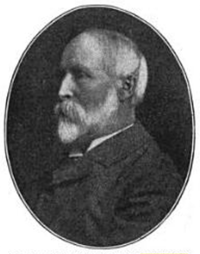History of the Stearns Collection of Musical Instruments
The Stearns Collection has grown immensely since its inception in 1899. Below is a timeline of significant events in the history of the collection.
For a more detailed history, see the article “Frederick Stearns, Leopoldo Franciolini, and the Making of the Stearns Collection,” written by former director and Professor Emeritus James Borders celebrating the collection’s 100th anniversary.

Frederick Stearns
1899 – Frederick Stearns (1831-1907), a successful Detroit businessman in the pharmaceutical industry, donates an eclectic collection of 940 musical instruments to the University of Michigan.
1914 – The entire collection is displayed in Hill Auditorium in the encyclopedic manner typically found in the early history of museums.
1956 – Professor Robert A. Warner becomes the director of the collection at a time when interest in historically-informed performance is emerging in the musical and scholarly worlds. In furthering this new interest and in realizing the musical and cultural value of the instruments, Professor Warner begins a process of restoration while promoting the collection through performances and scholarly papers and lectures.
1960 – The collection expands significantly with the establishment of an ethnomusicology program. Professors William Malm and Judith Becker add many instruments to the Collection from their field work.
1966 – The collection acquires a complete Javanese gamelan, today comprising seventy-five gongs, percussion and other instruments, which has become an integral part of the teaching and performance of world music at U-M.
1975 – Due to evolving standards in the style of museum display and out of concern for the long-term preservation of the instruments, the collection is moved from Hill Auditorium to the Stearns Building.
1980 – Professors William Malm and James Borders become the new director and associate director, launching efforts to further the mission of the collection. Among these, the publication of the Stearns Newsletter, and the establishment of the Virginia Martin Howard Lecture series are particularly noteworthy. During Professor Malm’s tenure, the Collection moves to the Argus Building and is organized into five categories of musical instruments (chordophones, membranophones, aerophones, idiophones and electrophones) and subdivided into geographical areas (Europe, Asia, Middle East, Africa, Oceania, South America and North America).
1986 – The Margaret Dow Towsley wing opens in the School of Music’s E.V. Moore Building, expanding display opportunities for the collection beyond the school’s library and lobby venues.
1992 – Virginia Martin Howard funds an endowment which establishes a permanent series of free, public lectures in the fields of organology, musicology, and ethnomusicology.
1993 – Professor Malm retires and is succeeded by Professors Margo Halsted and Joseph Lam, who formulate a new course of development for the collection with expanded musical programs and restoration projects for musical instruments.
2008 – Assistant Professor Steven Ball succeeds Professor Joseph Lam as the director of the collection. The collection’s online database, holding more than 13,000 digital images, is officially made available to the public for the first time in January 2011.
2017 – Professor Lester Monts becomes director and moves the collection to the North Campus Research Complex (NCRC) with state-of-the-art climate controlled storage for the instruments.
2019 – Professor Joseph Gascho takes on the directorship overseeing the continued growth of the collection, with an increased emphasis on using Stearns instruments in performance.
2020 – The Stearns Collection increases its outreach potential by incorporating remote lectures and livestream technology.
2023 – Professor Emeritus William Malm and Jutta Malm generously establish a permanent concert series to feature instruments from the collection.
Questions?
Contact the Stearns Collection: stearnsoutreach@umich.edu
